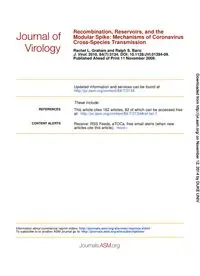
2010 Recombination, Reservoirs, and the Modular Spike_ Mechanisms of Coronavirus Cross-Species Transmission PDF
Preview 2010 Recombination, Reservoirs, and the Modular Spike_ Mechanisms of Coronavirus Cross-Species Transmission
Published Ahead of Print 11 November 2009. 2010, 84(7):3134. DOI: 10.1128/JVI.01394-09. J. Virol. Rachel L. Graham and Ralph S. Baric Cross-Species Transmission Coronavirus Modular Spike: Mechanisms of Recombination, Reservoirs, and the http://jvi.asm.org/content/84/7/3134 Updated information and services can be found at: These include: REFERENCES http://jvi.asm.org/content/84/7/3134#ref-list-1 at: This article cites 162 articles, 82 of which can be accessed free CONTENT ALERTS more» articles cite this article), Receive: RSS Feeds, eTOCs, free email alerts (when new http://journals.asm.org/site/misc/reprints.xhtml Information about commercial reprint orders: http://journals.asm.org/site/subscriptions/ To subscribe to to another ASM Journal go to: on November 12, 2014 by DUKE UNIV http://jvi.asm.org/ Downloaded from on November 12, 2014 by DUKE UNIV http://jvi.asm.org/ Downloaded from JOURNAL OF VIROLOGY, Apr. 2010, p. 3134–3146 Vol. 84, No. 7 0022-538X/10/$12.00 doi:10.1128/JVI.01394-09 Copyright © 2010, American Society for Microbiology. All Rights Reserved. MINIREVIEW Recombination, Reservoirs, and the Modular Spike: Mechanisms of Coronavirus Cross-Species Transmission� Rachel L. Graham1 and Ralph S. Baric1,2* Departments of Epidemiology1 and Microbiology and Immunology,2 University of North Carolina at Chapel Hill, Chapel Hill, North Carolina 27599 Over the past 30 years, several cross-species transmission events, as well as changes in virus tropism, have mediated significant animal and human diseases. Most notable is severe acute respiratory syndrome (SARS), a lower respiratory tract disease of humans that was first reported in late 2002 in Guangdong Province, China. The disease, which quickly spread worldwide over a period of 4 months spanning late 2002 and early 2003, infected over 8,000 individuals and killed nearly 800 before it was successfully contained by aggressive public health intervention strategies. A coronavirus (SARS-CoV) was identified as the etiological agent of SARS, and initial assessments determined that the virus crossed to human hosts from zoonotic reservoirs, including bats, Himalayan palm civets (Paguma larvata), and raccoon dogs (Nyctereutes procyonoides), sold in exotic animal markets in Guangdong Province. In this review, we discuss the molecular mechanisms that govern coronavirus cross-species transmission both in vitro and in vivo, using the emergence of SARS-CoV as a model. We pay particular attention to how changes in the Spike attachment protein, both within and outside of the receptor binding domain, mediate the emergence of coronaviruses in new host populations. Coronavirus (CoV) phylogeny and biology, as demonstrated during the severe acute respiratory syndrome (SARS) epi- demic in 2002-2003, are likely characterized by frequent host- shifting events, whether they be animal-to-human (zoonosis), human-to-animal (reverse zoonosis), or animal-to-animal (26, 44, 67, 115). Over the past 30 years, several coronavirus cross- species transmission events, as well as changes in virus tropism, have given rise to significant new animal and human diseases that implicate bovine coronavirus (BCoV), human coronavirus OC43 (HCoV-OC43), human coronavirus 229E (HCoV-229E), canine coronavirus (CCoV), feline coronavirus (FCoV), por- cine coronavirus (PCoV), and transmissible gastroenteritis vi- rus (TGEV) (1, 58, 79, 80, 103, 104, 143, 144). Most notably, severe acute respiratory syndrome (SARS), a lower respiratory tract disease of humans that was first reported in late 2002 in Guangdong Province, China, quickly spread worldwide over a period of 4 months spanning late 2002 and early 2003 and infected over 8,000 individuals, killing nearly 800 before it was successfully contained by aggressive public health intervention strategies (25, 69, 101, 102, 160). A coronavirus (SARS-CoV) was identified as the etiological agent of SARS, and assess- ments determined that the virus crossed to human hosts, most likely in southern China in Guangdong Province, from zoo- notic reservoirs, including bats (74), Himalayan palm civets (Paguma larvata), and raccoon dogs (Nyctereutes procyonoides), the latter two of which are sold in exotic animal markets (44). In this review, we discuss the pleiotropic molecular mecha- nisms that govern coronavirus cross-species transmission both in vitro and in vivo, paying particular attention to SARS-CoV and SARS-like-CoV transmission events as models, comparing and contrasting the diversity of mechanisms governing virus cross-species transmission in outbreak settings. Coronaviruses are enveloped RNA viruses that infect and cause disease in a broad array of avian and mammal species, including humans. They contain the largest single-stranded, positive-sense RNA genomes currently known, ranging in size from 27 to nearly 32 kb in length. SARS-CoV, at 29 kb, encodes nine open reading frames (ORFs) (20, 84, 115). While all CoVs carry strain-specific accessory genes in their downstream ORFs, the order of essential genes—the replicase/transcriptase gene (gene 1), Spike gene (gene 2 in SARS-CoV), envelope gene (gene 4), membrane gene (gene 5), and nucleocapsid gene (gene 9)—is remarkably conserved (Fig. 1). Within the virion, genome single- stranded RNA (ssRNA) is encased in a helical nucleocapsid com- posed of many copies of the nucleocapsid (N) protein. The lipid bilayer envelope contains three proteins, envelope (E) and mem- brane (M), which coordinate virion assembly and release, and the large peplomer, S. Multiple copies of the S glycoprotein decorate the surfaces of CoV virions, conferring the virus’s characteristic corona shape. S also serves as the principle mediator of host cell attachment and entry, utilizing virus- and host-specific cell recep- tors. For SARS-CoV, the angiotensin 1-converting enzyme 2 (ACE2) molecule has been shown to serve as a receptor (73); CD209L has been implicated as a coreceptor in entry (57). Re- ceptor usage, as well as binding of other molecules, varies by group and even by strain among the coronaviruses (Table 1) (31, 34, 43, 48, 57, 73, 83, 85, 109, 118, 137, 145, 148, 155); however, in the majority of studies to date, S—in particular the receptor binding domain (RBD) of S—remains the principal player in determining host range (10, 30, 110, 117, 134, 135, 138). * Corresponding author. Mailing address: Department of Epidemi- ology, School of Public Health, University of North Carolina at Chapel Hill, 2105D McGaveran Greenberg Hall, CB7, Chapel Hill, NC 27599. Phone: (919) 966-3895. Fax: (919) 966-2089. E-mail:
